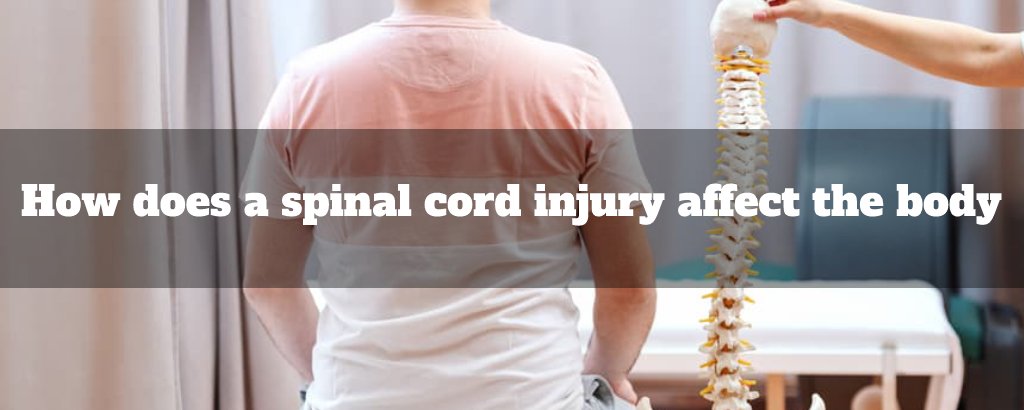How a spinal cord injury affects the body function usually depends upon the type of injury, like traumatic spinal cord injury or acute spinal cord injury.
There is no universal injury protocol because every person is unique. In a complete injury, the damage occurs “throughout” the spinal column at the injury site and causes loss of sensation below the level of injury. More profound injuries might cause paralysis below the injury site.
An incomplete injury means that only a portion of the spinal cord is damaged. Below the point of injury, in the buttocks and rectal area, some sensation or movement persists.
David Greene, a general physician, shared his thoughts on spinal cord injury and its effects on the body. The spinal cord transmits messages from the brain to the rest of the body’s sensory and motor systems.
A spinal cord injury can cause multiple impairments. The inability to walk and physical limitations are expected outcomes of traumatic spinal cord injuries (SCI). However, people regain the ability to do basic tasks such as moving and feeling. Their bodies could suffer mild to severe injuries.
The extent of movement and sensation is affected by the location and severity of the cord damage.

After suffering a spinal cord injury, the spinal cord may swell, which can have far-reaching consequences. Some individuals will regain some bodily functions in days to weeks as the swelling diminishes. However, very few people ever make a full recovery of their physical abilities.
Here are some of the most prevalent ways spinal cord injuries affect the body.
Spinal Shock.
It is the transient loss of sensation or reflexes below the cord injury level. When the spinal shock subsides, spasticity or stiffness begins below the degree of damage to the spinal cord.
This cannot be prevented and usually resolves on its own.
Limb weakness.
The spinal cord acts as the body’s “wires and switches” by relaying messages to muscles, thereby causing movement.
When a person suffers a spinal cord injury, the nerve cells that carry commands from the brain to the limbs are disrupted. The brain loses control over the limbs, causing no or little muscle movement.
This prevents you from walking or using your arm at a rate of 1% every year.
Muscle Atrophy.
When muscles are not regularly used, atrophy is the next big problem. Consider the phrase, “use it or lose it.”
Reduced activity and weight-bearing in the legs cause the muscles to atrophy to conserve energy, as the bodies are continually changing to the way.
Osteoporosis.
It is common for people with spinal cord injuries to experience diminished mobility and be unable to walk as far or as often as they did before their injury. Bone loss in SCI patients is estimated to occur at an average monthly rate of 4%.
Loss of bone mineral density (osteoporosis) below the level of injury occurs because the legs are no longer required to sustain the body’s weight.
Complete spinal cord injuries are associated with more severe osteoporosis. Even unmanaged osteoporosis progresses slowly over the years.
Pressure Ulcers.
If there is a complete spinal cord injury, skin sensations may be gone. Therefore, skin cannot notify your brain when it is damaged, even after experiencing an injury from continuous pressure-causing pressure sores.
Pressure ulcers develop when the skin covering the pressure sites is not moved and is repeatedly injured, especially over bony prominences.
It can be challenging to treat ulcers when they spread to the muscles and bones or cause infection. The incidence of pressure ulcers starts at 15% in the first year following injury and rises progressively from there.
Impaired Breathing.
Weakened breathing muscle tone is a typical consequence of spinal cord injury. The location of the spinal cord damage will have the most significant bearing on its effects on the lungs.
Any injury above C4 will restrict diaphragm movement, making it harder to take deep breaths. Injuries between T1 and T7 impact the intercostal muscles, whereas injuries above T7 affect the abdominal muscles.
All three muscle groups are necessary for effective breathing and coughing. This causes hypoventilation, also known as respiratory depression, which is slower, less efficient breathing.
Up to 80% of individuals in the acute phase after a spinal cord injury experience breathing difficulties.
Pain.
A spinal cord injury causes acute or persistent pain. Bruising, fractures, surgery, or placement can produce acute discomfort, while overuse or changes in muscles, joints, and ligaments can cause chronic pain.
Individuals with spinal cord injuries frequently report tingling and numbness in their extremities, as well as swelling of the hands and feet.
Loss Of circulation.
Because of the severity of most spinal cord injuries, localized disruption of blood flow quickly spreads to the neighboring tissues and organs. Loss of circulation dramatically decreases blood pressure and heart rate since the body cannot maintain its normal levels.
Extremity swelling and low blood pressure upon standing (orthostatic hypotension) are just two circulatory issues that can arise after a spinal cord injury.
These alterations to blood flow can also raise the probability of developing deep vein thrombosis, which happens when a blood clot forms in the legs due to immobility.
All possible outcomes are lower extremity swelling, pain, and impaired blood flow.
A pulmonary embolism can also occur if a clot fragment reaches the lung tissue. When blood clots form in the lungs’ arteries, breathing becomes harder and more painful.
Increased blood pressure is another potentially serious issue with spinal cord injuries. This can lead to autonomic dysreflexia. Those with spinal cord injuries higher than T6 are more likely to develop this condition.
The autonomic nervous system controls automatic bodily processes like temperature, heart rate, and blood pressure. Consequently, when areas below the degree of damage are stimulated, people may feel:
- Increase in resting blood pressure.
- Blotched skin.
- Anxiety.
- Headaches.
- Blurry vision.
- Sweating.
The condition is life-threatening and requires immediate medical attention. Seizures, heart attacks, and strokes are all possible repercussions if this isn’t addressed.
Inability to control body temperature.
When the body’s nervous system is compromised, one might not be able to feel cold or sweat below the degree of injury. This is because SCIs mess up how nerves in the central nervous system and the rest of the body feel.
Thus, maintaining a steady internal temperature can be challenging.
Hyperthermia happens when the body is unable to cool itself down and overheats. This is exceedingly harmful and can cause permanent organ damage or even death.
On the other hand, hypothermia, where the body cannot produce enough heat and hence becomes excessively cold, may occur in some patients who have sustained spinal cord injuries.
Decreased bladder control.
The spinal nerves that supply the bladder are not immune to the effects. Consequences include spasms and incontinence of the bladder and, in some cases, urinary tract infections.
https://www.youtube.com/watch?v=kmcsrNxWEQo
Spinal cord injuries can cause problems with blade function, as explained by Dr. Sean Elliot, at the University of Minnesota.
Individuals with total loss of sensory function will be unable to sense when their bladder is full, necessitating strict control over fluid intake and a carefully planned schedule of bathroom breaks.
Changes in bowel function.
The rectus and anus nerves are also affected. Because of this, many people resort to using laxatives or suppositories to help them defecate.
It is common for those recovering from a spinal cord injury to require help with bowel and bladder movements, especially in the immediate post-injury period. It may take some time, but it is possible to train them.
Sexual function.
Loss of sexual feelings can affect both sexes. The extent to which a person’s sexuality is affected by an injury varies from person to person.
A man who suffers a spinal cord injury may experience difficulties with erection and ejaculation, while a woman may have trouble maintaining lubrication.
This article discusses how your partner can make love to you.
Syringomyelia.
In syringomyelia, the spinal cord develops a cyst or cavity. Affected individuals may have tingling or limb weakness due to this condition. After a spinal injury, syringomyelia symptoms may arise months or even years later.
It is incurable and worsens over time. Injured people may need surgery to drain cysts.
Emotional And Brain Health
However, the emotional ramifications are just as taxing because many spinal cord injuries occur unexpectedly. It’s a huge blow to suddenly slow down after being constantly active. Depression and even suicidal ideation may result.
Spinal cord injuries: what survivors have learned.
Full-recovery SCI patient Tiffiny Carlson is a C5-C6 quadriplegic who aspires for independence and inspires others. Carlson suffered cervical spinal damage at age 14 in a Minnesota diving accident. The functional and neurological damage she sustained in the accident was suggestive of a total spinal cord injury. Carlson claims to have limited finger and tricep movement and occasional bicep and wrist movement. Carston is a fitness freak and follows a nutritious diet and practices adapted yoga and other forms of physical activity to keep her body moving, all of which are highly advised for people with complete spinal cord injuries to reduce the risk of developing secondary issues.
Kelly Glenzer shared her story of her paralyzed in a motor vehicle accident, damaging her T12 vertebrae. After spending 11 days in the hospital after emergency surgery, she was transferred to a level 1 local trauma center and accepted to undergo physical therapy in the spinal cord injury unit for 30 days. She says she is proficient in using a catheter, a wheelchair, and even a walker for the few steps I need to get about the house. It took her two years to go from using a wheelchair to walking with regular forearm crutches. Life is lived one day at a time. You have your good days and your bad days… I just kept going forward without stopping.
Sally shares her thoughts after a motor vehicle accident on January 25 of this year. The wound isn’t quite as bad as it first appeared. Despite the foot drop in her right leg, she can walk normally with the aid of an ankle-foot orthosis. People may think that she is well yet. Still, she has footdrop, clawed toes, numbness, and an inability to sweat. The effects of a spinal cord injury are quite individual. Don’t give up. I know you can walk again if you want to.
In this video, Declan, another survivor of spinal injury, shares his recovery story.
A spinal injury can alter many aspects of your life. You may feel paralyzed in more ways than one, yet you’d be surprised at how much a human can accomplish despite a damaged spinal cord.
However, treatment and physical therapy can help lessen the severity of some of the physical challenges of living with a spinal cord injury.

